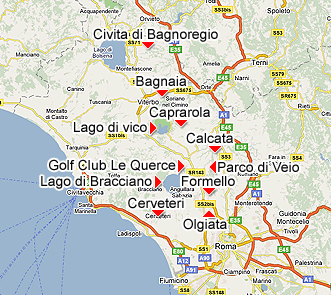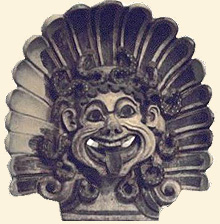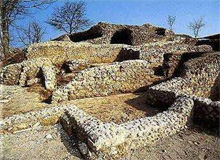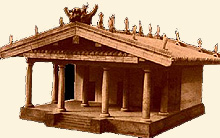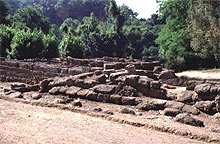|
Veio (Veii)
|
|
|
Gorgon Antefix from the
temple at Portonaccio
|
The ruins of Veii are located about 20 km northwest
of Rome. Veii was the greatest centre for the fabrication of terra-cotta
sculptures in Etruria in the 6th century BCE. The town had hegemony
over Rome in the 7th and 6th centuries; but a subsequent series
of wars eventually ended in its destruction. In its heyday Veii
was as big as Athens and had a population of about 100,000 inhabitants.
In origin, Veii appears to have been a conglomeration of Villanovan
villages during the 9th and 8th centuries BCE, the graveyards
of which occupied the rocky plains around the city. One of the
chambered tombs, the Grotta Campana, contains the oldest known
Etruscan frescoes. The ashes of the dead were stored in burial
urns surmounted by archaic terra-cotta portrait heads. Nearby
are the remains of the Temple of Portonaccio, home of the terra-cotta
statue of the "Apollo
of Veii" by Vulca and also a temple shrine dedicated
to the neighbouring Cremera River.
Although the Etruscan monarchy had been pulled down late in the
Sixth Century BCE, traditionally in 509, many Etruscan city -
states remained powerful for another two centuries and a threat
to Rome for at least one hundred twenty years until its defeat
in 396 BCE.
Veii was the only city - state in Rome's immediate vicinity considered
powerful enough to be a serious threat to Rome's continued growth
and expansion, and even Rome's very survival. was at stake. Rome
and Veii were physically too close to one another and too well
matched in strength for any treaty between the two to adequately
guarantee the safety of one from the other.
In the 480's BCE, the Fabian Gens was one of the most powerful
familial groups in Rome. The Fabii had major Etruscan connections
and owned a considerable tract of land between Rome and Veii.
A major strategic point on the Via Salaria, or Salt Road between
Rome and Veii was where the stream Cremora joined the Tiber. The
Fabii and the Veians came into conflict with each other during
this period, mainly through mutual cattle raiding. Then, the Fabii
built a defensive blockhouse at the Cremora which the Veians considered
a challenge thrown in their teeth. Now the Fabii had raised a
large semi - private army who owed their allegiance not to the
Roman state but to the Fabian Gens. Thre hundred of the Fabii
and their clients occupied the blockhouse with intentions of holding
this strongpoint against Veii in 476. This led to the Battle of
the Cremora in which three hundred Fabii were killed and the area
was abandoned to the Veiians. Another strategic town occupied
at this time by the Veiians was Fidemae, also at the confluence
of the Cremora and the Tiber. The Veiians now controlled the entire
west bank of the Tiber which included the Janiculum Hill which
overlooked Rome. The stage was now set for a decisive showdown
between the two cities.
The Romans had seen this coming for many years in advance. The
new Republican government had been established under the leadership
of two civilian magistrates, the Consuls for each year. In 444
BCE, they replaced the two civilian consuls with three military
officers with consular powers -- the tribuni militum consularii
potestate. Two other magistrates, the Censors, were instituted
whose term of office lasted eighteen months. The responsibility
of the censors was to examine the property rolls of the citizend
of Rome and determine who had the privelege and responsibility
of military service, and whether his property qualified him as
an equestrian or infantry warrior. Military service was not an
option to men of little or no property, a situation which Rome
later found necessary to change during periods of crisis.
Less than a year after Cremora came the crushing defeat of the
Etruscan navy off Cumae. Veii was forced to make a treaty with
Rome in spite of the recent victory at Cremora.
Fidemae was first retaken from Veii, and then the city of Veii
itself came under siege. According to tradition the Siege of Veii
lasted 10 years from 406 to 396 BCE (although subsequent information
indicates that it only lasted 6 years). This heroic legend was
invented in order to draw a parallel with the ten year Siege of
Troy of Homeric legend. The actual siege of Veii lasted probably
6 years and was broken when the Romans diverted the drainage channel
that supplied water to the city. Roman soldiers sneaked under
the wall through the now diverted stream bed and let their comrades
in through the locked gates.
|
|
|
Remains of houses at Veii
|
The capture of the Etruscan city of Veii in 396
BC by the soldier and statesman Marcus Furius Camillus spelled
the beginning of the end for Etruscan independence. The Romans
destroyed much of the city of Veii, driving off the inhabitants
and parceling out the captured land to their own citizens. This
is in contrast to the way Rome's former rivals were treated upon
their defeat, which was to incorporate the defeated city into
the growing state of Rome. Veii was such a dangerous enemy that,
evidently, the Romans wanted there to be no chance of their eventual
recovery and renewal of their position as a threat to Rome. It
set a new and more sinister precedent in Rome's treatment of vanquished
enemies.
Archaeology
|
|
|
|
Model of the temple at
Portonaccio
|
The podium of the temple
as it is today
|
Although the city of Veii was well known through
the writings of Dionysius of Halicarnasso and Livius, for a long
time, the location of Veii was forgotten. It was only rediscovered
in the 1840's. A number of tombs were discovered nearby. These
included the Campana tomb, named after its discoverer the Marchese
Campana; the tomb of the ducks, dated at about 680 BCE and believed
to have the oldest wall paintings in Etruria.
In the early 20th Century, the temple of Portonaccia was discovered
and with it such masterpieces as the Apollo of Vulca and the Mother
and child statue. On discovering the Apollo in 1916, the Italian
archaeologist G. Giglioli was so overcome with emotion that he
smothered it with kisses. The Apollo is considered one of the
masterpieces of the Etruscan sculptor Vulca, and is a formidable
and moving sight in the Villa Giulia Museum in Rome.
Timeline For Veii
8th Century BCE
650 BCE:
560 BCE (approx):
483 - 474 BCE:
474 BCE:
438 - 425 BCE:
428 BCE:
406 BCE:
396 BCE: |
First Settlement by Etruscans
First Necropolis built
Revolt of the Vibenna brothers
Early wars of Rome with Veii
Defeat of Etruscan fleet at Cumae
Veii's second war with Rome
Death of Lars Tolumnius, Lauchum of Veii
Start of Siege of Veii
Fall of Veii |
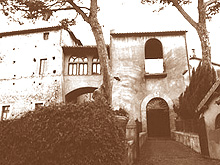
Parco di Veio
The territory of the Park is extremely rich in historical and
artistic resources. The most ancient evidences date back to
the Etruscan age: among the others, the prestigious remains
of the ancient town of Veio with its entrances, like the natural
entrance of Ponte Sodo dating back to the 5th century BC, which
is one of the most suggestive. In the tufaceous plains surrounding
the remains of the towns there are several necropolis and the
famous "Tomba delle Anatre", which is considered the
most ancient painted grave in Italy, dating back to the 7th
century BC.
The communication structures among Veio, Rome and the nearby
Etruscan centers are still clearly visible: via Cassia, via
Veientana and a transversal communication axis with via Flaminia
and the Tiber Valley. Among the Etruscan evidences, the sanctuary
of Apollo (6th century BC) is worth a mention: it is situated
in the locality Isola Farnese and actually dedicated to Minerva.
It is possible to see the rests of the temple,
of the swimming pool, and of the sacred area where the famous
statue of the god Apollo was found. The statue is nowadays preserved
in the National Etruscan Museum of Villa Giulia in Rome.
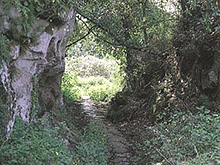 Some great and luxurious buildings
date back to the Roman period: among them, Livia's villa, built
during the 1st century BC near Prima Porta; Lucio Vero's villa,
near Nero's Grave (at about km 9 of the Cassia); Casale Ghella's
villa (km 11 of the Cassia) and the Graves Celsa (km 12,7 of
the Flaminia Vecchia), of the Nasoni and of Fadilla (both dating
back to the 2nd century AD); moreover, the columbaria of Porta
di Capena near Veio.
Some great and luxurious buildings
date back to the Roman period: among them, Livia's villa, built
during the 1st century BC near Prima Porta; Lucio Vero's villa,
near Nero's Grave (at about km 9 of the Cassia); Casale Ghella's
villa (km 11 of the Cassia) and the Graves Celsa (km 12,7 of
the Flaminia Vecchia), of the Nasoni and of Fadilla (both dating
back to the 2nd century AD); moreover, the columbaria of Porta
di Capena near Veio.
In the territory of the Patrimonio di S. Pietro in Tuscia, several
agricultural firms called "domuscultae" were founded
in the Middle Ages. The towers of the Cornacchie (km 14,8 of
via Cassia), of Porta Pertusa (km 18 of Flaminia) and of Prima
Porta also date back to this period.
Of great importance are the castle and the village of Isola
Farnese (10th-11th century AD) and the Sanctuary of the Sorbo
(15th century AD), the Mola Paradisi (16th century AD), the
Casale Malborghetto (at km 19,7 of Flaminia) and the town Belmonte
near Castelnuovo di Porto.
Veio
It was the southernmost Etruscan town, situated on a large volcanic
plain at about 17 km north-west of Rome, delimited by the watercourses
Fosso del Piordo and Valchetta (the ancient Crèmera).
At the south-eastern edge of the plateau, there was the acropolis
called "Piazza d'Armi". The town flourished around
the 6th and 5th century BC. The agriculture, the flourishing
artistic production, and the fruitful trading activities led
to the wars against Rome for the control of the river Tiber.
After ten years of siege, Veio fell under Furio Camillo in 396
BC. Subsequent news on the history of the territory can be found
with the birth of the rural colony of in the 9th century AD
and with the fortress Castrum Insulae, Isola Farnese,
in the 11th century. The several finds which have been discovered
are preserved in the National Etruscan Museum of Villa Giulia
in Rome.
Belmonte
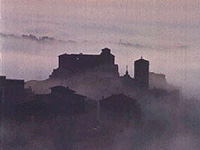 The settlement of Belmonte, at
about one kilometer and a half from Castelnuovo di Porto, is
situated in a position dominating a large valley on the left
of the via Flaminia. Belmonte was an Etruscan oppidum,
probably founded by the settlers of the town of Veio around
the 7th century BC. On the southern-western side it is still
possible to see the remains of the walls which were directly
built on the edge of the cliff through foundations set in the
outcropping tuff. The walls have a width of 1,90 meters and
are preserved for a height of 1,60 meters; within them there
is an inclined filling embankment (ager), containing very small
fragments of ceramics which can be dated back to the period
between the 3rd and the 2nd century BC. Even if we do not have
many documents about it, the settlement was inhabited since
the Middle Ages: as a matter of fact, the rests of the tower
situated in the highest part of the plain date back to the 12th
century.
The settlement of Belmonte, at
about one kilometer and a half from Castelnuovo di Porto, is
situated in a position dominating a large valley on the left
of the via Flaminia. Belmonte was an Etruscan oppidum,
probably founded by the settlers of the town of Veio around
the 7th century BC. On the southern-western side it is still
possible to see the remains of the walls which were directly
built on the edge of the cliff through foundations set in the
outcropping tuff. The walls have a width of 1,90 meters and
are preserved for a height of 1,60 meters; within them there
is an inclined filling embankment (ager), containing very small
fragments of ceramics which can be dated back to the period
between the 3rd and the 2nd century BC. Even if we do not have
many documents about it, the settlement was inhabited since
the Middle Ages: as a matter of fact, the rests of the tower
situated in the highest part of the plain date back to the 12th
century.
Malborghetto
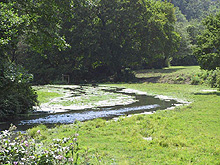 At the Km 19,200 of the via Flaminia
there is the Casale di Malborghetto: the building reminds of
a brick tower, but the farmhouse derives from a four-front arch
dating back to the first half of the 4th century AD. The most
convincing hypothesis is that the monument was built to celebrate
the victory of Constantine over Maxentius in 312 AD. Since then,
the building has been subject to subsequent changes: however,
the structure of the brick Roman arch is still clearly visible.
At the Km 19,200 of the via Flaminia
there is the Casale di Malborghetto: the building reminds of
a brick tower, but the farmhouse derives from a four-front arch
dating back to the first half of the 4th century AD. The most
convincing hypothesis is that the monument was built to celebrate
the victory of Constantine over Maxentius in 312 AD. Since then,
the building has been subject to subsequent changes: however,
the structure of the brick Roman arch is still clearly visible.
The elements which have been found allowed a reconstruction
with couples of Corinthian columns in front of each pillar,
on the major side. It is possible to visit the interior of the
monument, since it is used as a museum; it houses remains which
have been found in the adjacent area and very near the farmhouse
and date back to the Etruscan and Roman epochs and to the Renaissance.
In the small park surrounding the monument it is possible to
observe some parts of the 13th century AD walls and the southern
entrance made of little blocks of tuff belonging to the medieval
district.
Museum of Villa Giulia
(entrance on payment)
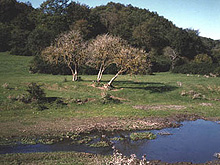 In 1889 the National Etruscan Museum
of Villa Giulia was established: it is housed in the 16th century
villa which pope Giulio III wanted to build at the beginning
of via Flaminia. Artists like Vignola, Vasari and Michelangelo
worked at the project.
In 1889 the National Etruscan Museum
of Villa Giulia was established: it is housed in the 16th century
villa which pope Giulio III wanted to build at the beginning
of via Flaminia. Artists like Vignola, Vasari and Michelangelo
worked at the project.
The museum gathers archaeological material coming from several
towns of Southern Etruria, excluding Tarquinia, and from some
centers in Umbria and Lazio. Moreover, there are collections
belonging to the State and collections gathered by the Pope's
State.
The frescoes and the park of the villa, the bookshop near the
ticket office, the didactic area for students and the orangery
complete the frame.
Valli del Sorbo
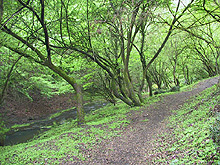 A scantly populated area between
the Towns of Campagnano di Roma and Formello, it has preserved
a landscape which is in some cases natural and wild. The place
was already known in the 10th century as a castle; at the beginning
of the 15th century a monastery was built on the ruins of the
destroyed castle, and the place was called Madonna del Sorbo.
A scantly populated area between
the Towns of Campagnano di Roma and Formello, it has preserved
a landscape which is in some cases natural and wild. The place
was already known in the 10th century as a castle; at the beginning
of the 15th century a monastery was built on the ruins of the
destroyed castle, and the place was called Madonna del Sorbo.
The valleys of the Sorbo are crossed by the river Crèmera,
an affluent of the river Tiber, with its gorges and wide clearings.
The 40-50 meter high cliff of volcanic rock on which the sanctuary
was built is very suggestive. The action of man determined the
formation of wide areas of pastures where still nowadays cows
and horses are bred in a wild state.
|

